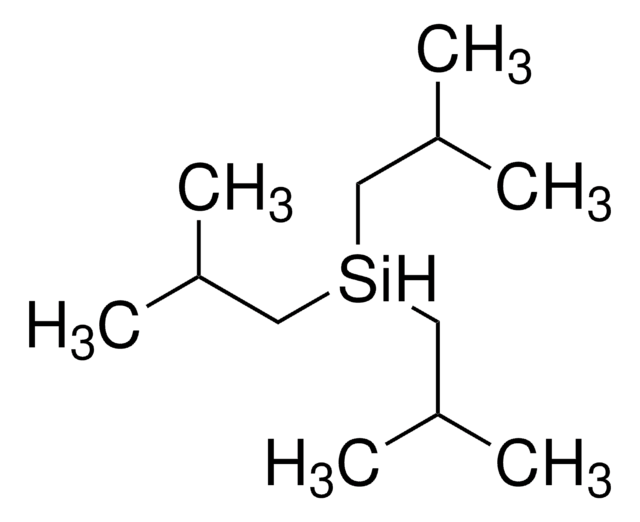All Photos(2)
About This Item
Linear Formula:
[(CH3)2CHCH2]3N
CAS Number:
Molecular Weight:
185.35
Beilstein:
1698950
EC Number:
MDL number:
UNSPSC Code:
12352100
PubChem Substance ID:
NACRES:
NA.22
Recommended Products
Assay
98%
refractive index
n20/D 1.423 (lit.)
bp
192-193 °C/770 mmHg (lit.)
density
0.766 g/mL at 25 °C (lit.)
SMILES string
CC(C)CN(CC(C)C)CC(C)C
InChI
1S/C12H27N/c1-10(2)7-13(8-11(3)4)9-12(5)6/h10-12H,7-9H2,1-6H3
InChI key
IIFFFBSAXDNJHX-UHFFFAOYSA-N
Looking for similar products? Visit Product Comparison Guide
General description
Triisobutylamine is a sterically hindered amine. The rate constants for H-atom abstraction from triisobutylamine has been evaluated.
Triisobutylamine is an organic base. Solubility and liquid-liquid equilibria of binary mixtures of triisobutylamine and water has been evaluated.
Application
Triisobutylamine is suitable to develop second generation ionic liquid matrices for MALDI-MS of peptides, proteins and carbohydrates. It may be used in the separation of cis-fatty acid salts and and trans-fatty acid (elaidic acid) salts using a new organic solvent nanofiltration membrane based on polydicyclopentadiene. It may be used as base in the synthesis of acroyl ammonium derivatives.
Signal Word
Danger
Hazard Statements
Precautionary Statements
Hazard Classifications
Acute Tox. 3 Dermal - Acute Tox. 3 Inhalation - Acute Tox. 4 Oral - Eye Dam. 1 - Flam. Liq. 3 - Skin Irrit. 2
Storage Class Code
3 - Flammable liquids
WGK
WGK 3
Flash Point(F)
134.6 °F - closed cup
Flash Point(C)
57 °C - closed cup
Personal Protective Equipment
dust mask type N95 (US), Eyeshields, Gloves
Choose from one of the most recent versions:
Already Own This Product?
Find documentation for the products that you have recently purchased in the Document Library.
Customers Also Viewed
Synthesis of a Fused ?-Lactone via Pyridine-Assisted [2+ 2] Cycloaddition.
Reddy LR and Corey EJ.
Synfacts, 06, 0550-0550 (2006)
IUPAC-NIST Solubility Data Series. 96. Amines with Water Part 2. C7-C24 Aliphatic Amines.
Goral M, et al.
Journal of Physical and Chemical Reference Data, 41(4), 043107-043107 (2012)
Nicholas A Isley et al.
Journal of the American Chemical Society, 135(47), 17707-17710 (2013-11-15)
New technology has been developed that enables Suzuki-Miyaura couplings involving widely utilized MIDA boronates to be run in water as the only medium, mainly at room temperature. The protocol is such that no organic solvent is involved at any stage;
Jeffrey A Crank et al.
Journal of the American Society for Mass Spectrometry, 20(10), 1790-1800 (2009-08-12)
Second generation ionic liquid matrices are developed, examined, and tested. They have shown a wide mass detection range (<1000 Da to >270,000 Da) for proteins and peptides with greater S/N ratios than solid matrices. These ionic liquid matrices also exhibit
Abhinaba Gupta et al.
ACS applied materials & interfaces, 5(3), 924-933 (2013-01-04)
This article describes the separation of mixtures of fatty acid salts using a new organic solvent nanofiltration membrane based on polydicyclopentadiene (PDCPD). Mixtures of free fatty acids could not be separated by the membranes because they permeated at similar rates.
Our team of scientists has experience in all areas of research including Life Science, Material Science, Chemical Synthesis, Chromatography, Analytical and many others.
Contact Technical Service













